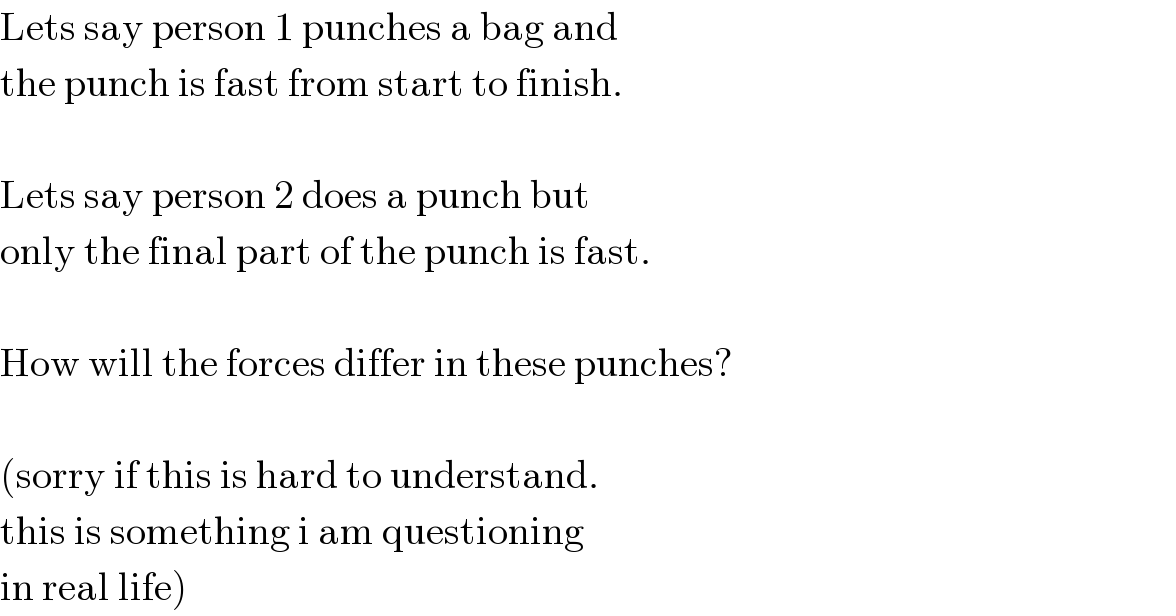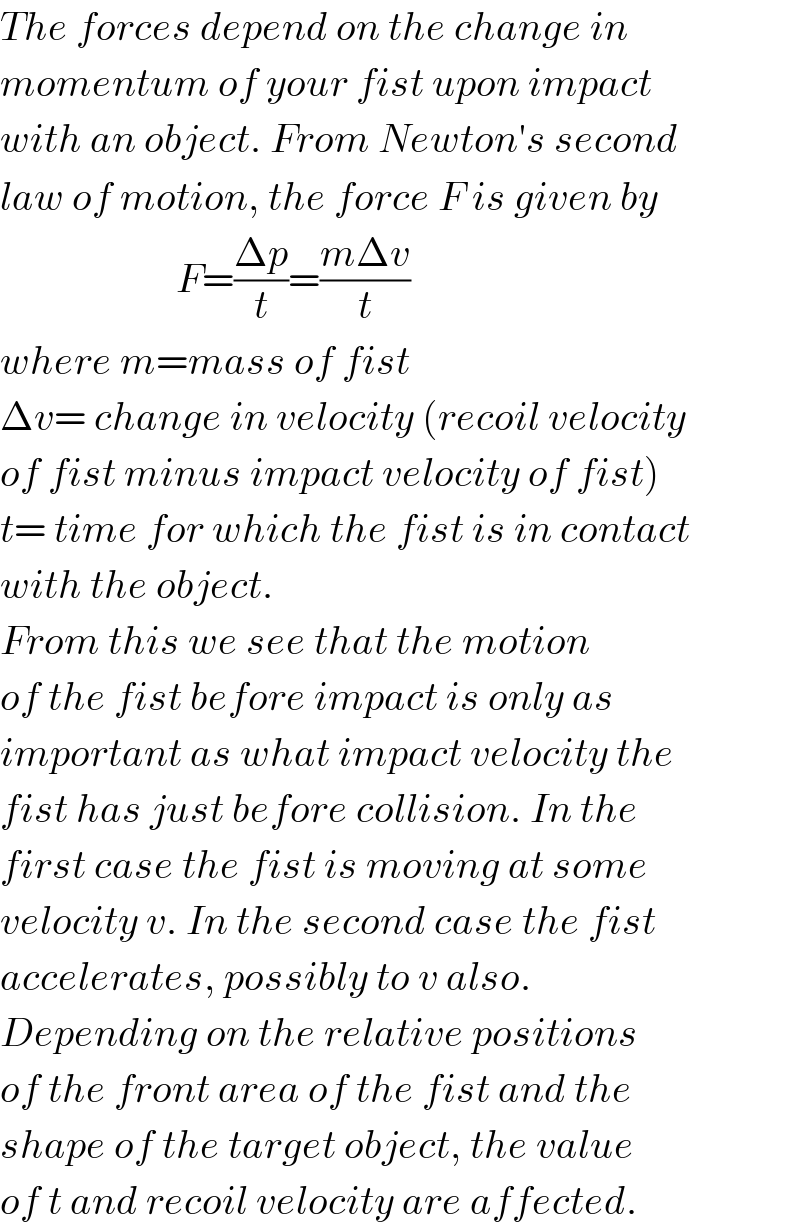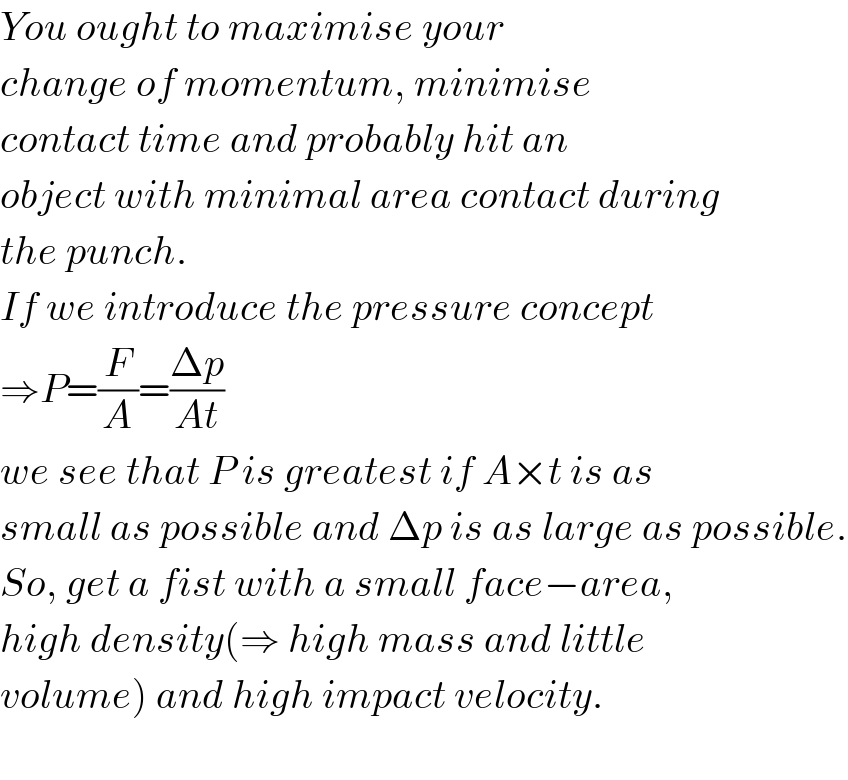
Question Number 5122 by FilupSmith last updated on 16/Apr/16

$$\mathrm{Lets}\:\mathrm{say}\:\mathrm{person}\:\mathrm{1}\:\mathrm{punches}\:\mathrm{a}\:\mathrm{bag}\:\mathrm{and}\: \\ $$$$\mathrm{the}\:\mathrm{punch}\:\mathrm{is}\:\mathrm{fast}\:\mathrm{from}\:\mathrm{start}\:\mathrm{to}\:\mathrm{finish}. \\ $$$$ \\ $$$$\mathrm{Lets}\:\mathrm{say}\:\mathrm{person}\:\mathrm{2}\:\mathrm{does}\:\mathrm{a}\:\mathrm{punch}\:\mathrm{but} \\ $$$$\mathrm{only}\:\mathrm{the}\:\mathrm{final}\:\mathrm{part}\:\mathrm{of}\:\mathrm{the}\:\mathrm{punch}\:\mathrm{is}\:\mathrm{fast}. \\ $$$$ \\ $$$$\mathrm{How}\:\mathrm{will}\:\mathrm{the}\:\mathrm{forces}\:\mathrm{differ}\:\mathrm{in}\:\mathrm{these}\:\mathrm{punches}? \\ $$$$ \\ $$$$\left(\mathrm{sorry}\:\mathrm{if}\:\mathrm{this}\:\mathrm{is}\:\mathrm{hard}\:\mathrm{to}\:\mathrm{understand}.\right. \\ $$$$\mathrm{this}\:\mathrm{is}\:\mathrm{something}\:\mathrm{i}\:\mathrm{am}\:\mathrm{questioning} \\ $$$$\left.\mathrm{in}\:\mathrm{real}\:\mathrm{life}\right) \\ $$
Commented by Yozzii last updated on 16/Apr/16

$${The}\:{forces}\:{depend}\:{on}\:{the}\:{change}\:{in} \\ $$$${momentum}\:{of}\:{your}\:{fist}\:{upon}\:{impact} \\ $$$${with}\:{an}\:{object}.\:{From}\:{Newton}'{s}\:{second} \\ $$$${law}\:{of}\:{motion},\:{the}\:{force}\:{F}\:{is}\:{given}\:{by} \\ $$$$\:\:\:\:\:\:\:\:\:\:\:\:\:\:\:\:\:\:\:\:\:\:{F}=\frac{\Delta{p}}{{t}}=\frac{{m}\Delta{v}}{{t}} \\ $$$${where}\:{m}={mass}\:{of}\:{fist} \\ $$$$\Delta{v}=\:{change}\:{in}\:{velocity}\:\left({recoil}\:{velocity}\right. \\ $$$$\left.{of}\:{fist}\:{minus}\:{impact}\:{velocity}\:{of}\:{fist}\right) \\ $$$${t}=\:{time}\:{for}\:{which}\:{the}\:{fist}\:{is}\:{in}\:{contact} \\ $$$${with}\:{the}\:{object}.\: \\ $$$${From}\:{this}\:{we}\:{see}\:{that}\:{the}\:{motion} \\ $$$${of}\:{the}\:{fist}\:{before}\:{impact}\:{is}\:{only}\:{as} \\ $$$${important}\:{as}\:{what}\:{impact}\:{velocity}\:{the} \\ $$$${fist}\:{has}\:{just}\:{before}\:{collision}.\:{In}\:{the} \\ $$$${first}\:{case}\:{the}\:{fist}\:{is}\:{moving}\:{at}\:{some} \\ $$$${velocity}\:{v}.\:{In}\:{the}\:{second}\:{case}\:{the}\:{fist} \\ $$$${accelerates},\:{possibly}\:{to}\:{v}\:{also}.\: \\ $$$${Depending}\:{on}\:{the}\:{relative}\:{positions} \\ $$$${of}\:{the}\:{front}\:{area}\:{of}\:{the}\:{fist}\:{and}\:{the} \\ $$$${shape}\:{of}\:{the}\:{target}\:{object},\:{the}\:{value} \\ $$$${of}\:{t}\:{and}\:{recoil}\:{velocity}\:{are}\:{affected}. \\ $$
Commented by FilupSmith last updated on 16/Apr/16

$$\mathrm{So},\:\mathrm{in}\:\mathrm{general},\:\mathrm{which}\:\mathrm{would}\:\mathrm{most}\:\mathrm{likely} \\ $$$$\mathrm{produce}\:\mathrm{the}\:\mathrm{most}\:\mathrm{force}? \\ $$
Commented by Yozzii last updated on 16/Apr/16

$${You}\:{ought}\:{to}\:{maximise}\:{your} \\ $$$${change}\:{of}\:{momentum},\:{minimise} \\ $$$${contact}\:{time}\:{and}\:{probably}\:{hit}\:{an}\: \\ $$$${object}\:{with}\:{minimal}\:{area}\:{contact}\:{during} \\ $$$${the}\:{punch}.\: \\ $$$${If}\:{we}\:{introduce}\:{the}\:{pressure}\:{concept} \\ $$$$\Rightarrow{P}=\frac{{F}}{{A}}=\frac{\Delta{p}}{{At}}\: \\ $$$${we}\:{see}\:{that}\:{P}\:{is}\:{greatest}\:{if}\:{A}×{t}\:{is}\:{as} \\ $$$${small}\:{as}\:{possible}\:{and}\:\Delta{p}\:{is}\:{as}\:{large}\:{as}\:{possible}. \\ $$$${So},\:{get}\:{a}\:{fist}\:{with}\:{a}\:{small}\:{face}−{area}, \\ $$$${high}\:{density}\left(\Rightarrow\:{high}\:{mass}\:{and}\:{little}\right. \\ $$$$\left.{volume}\right)\:{and}\:{high}\:{impact}\:{velocity}. \\ $$$$ \\ $$
Commented by FilupSmith last updated on 16/Apr/16

$$\mathrm{Thank}\:\mathrm{you}\:\mathrm{very}\:\mathrm{much}!!! \\ $$
